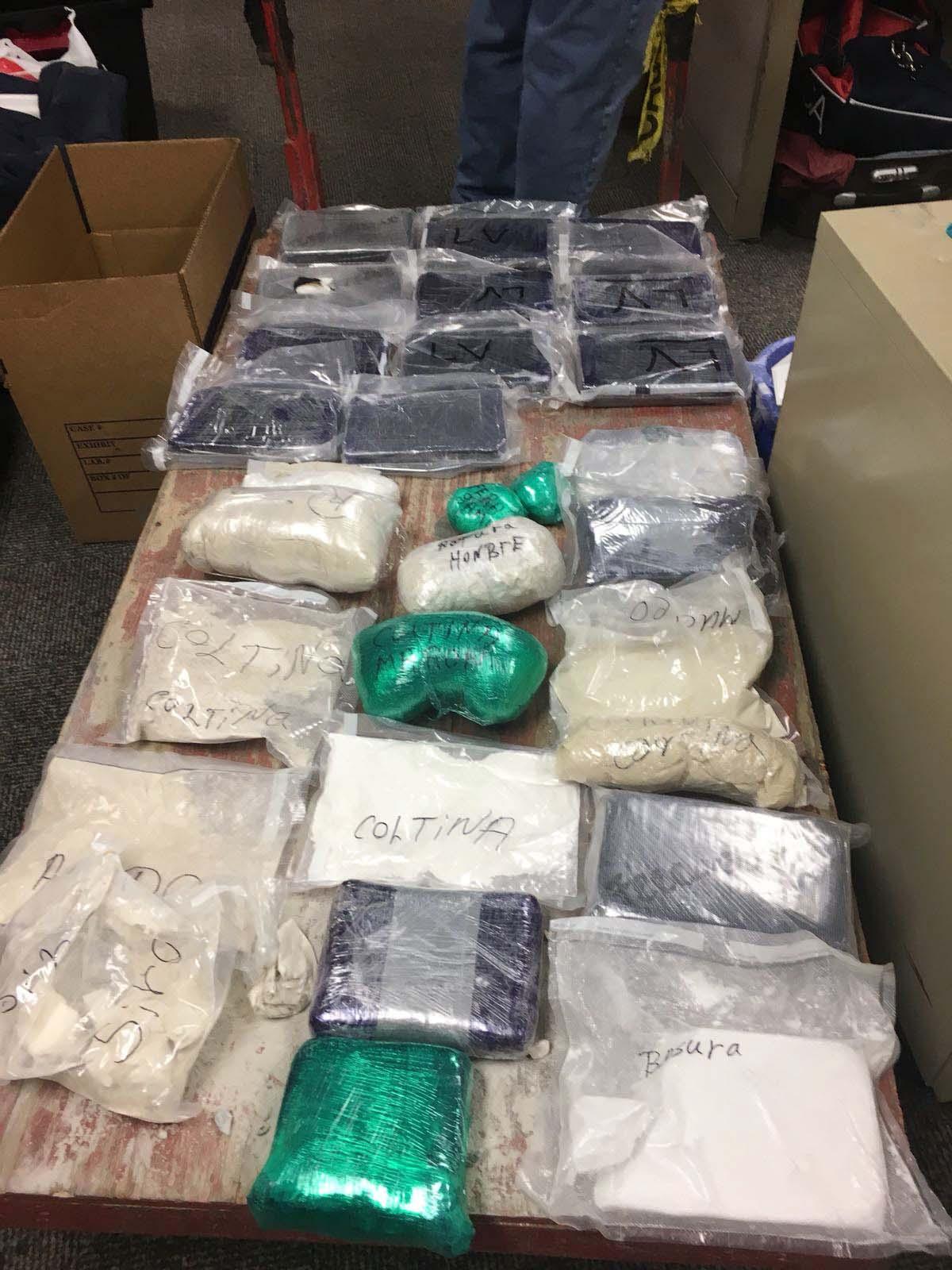Tuesday, October 2nd 2018
WASHINGTON (Sinclair Broadcast Group) — The U.S.-China trade relationship has dominated headlines in recent months, but it’s the illicit drug trade that some lawmakers and experts believe should be moved to the top of the list of issues between the two countries.
Last year, more than 49,000 Americans died from opioid-related overdoses. The majority of those deaths, 60 percent, involved fentanyl, a synthetic opioid up to 50 times more potent than heroin. Between 2014 and 2016, the number of fentanyl-related deaths skyrocketed by almost 600 percent.
China leads the world in the production and supply of fentanyl and the chemical precursors used to manufacture the drug. Roughly 68 percent of all global fentanyl movements originate in China, according to the Defense Intelligence Agency.
The United States is currently pouring billions of dollars into combating the opioid epidemic. Law enforcement agents have been given emergency authorities to try to control the flow of fentanyl and target opioid “kingpins.” Border and customs officials have seized record amounts of fentanyl and other synthetic opioids this year but the drug crisis continues to get worse.
At a Tuesday hearing of the Senate Caucus on International Narcotics Control, lawmakers, drug control officials and experts argued for addressing the source of the problem, namely, China’s outsized role in fueling the U.S. opioid epidemic.
TRACKING THE FLOW OF FENTANYL
“China is the number one problem when it comes to illegal fentanyl coming into the United States,” said Sen. Chuck Grassley, R-Iowa.
China is one of the world’s largest producers of the precursor chemicals used to manufacture fentanyl and other synthetic opioids. It also leads the world in making the chemicals used to process heroin, cocaine and methamphetamines. That production is largely unregulated by Chinese authorities, making it easy for local actors to divert supplies to overseas buyers.
U.S.-based traffickers and consumers can go online and easily order fentanyl off the dark web at up to 90 percent purity and have it shipped overseas through the U.S. Postal Service or other international mail carriers. Congress passed legislation last month — the Synthetics Trafficking and Overdose Prevention Act, or STOP Act — to prevent the exploiting of the Postal Service by drug traffickers. That included provisions for sophisticated equipment to detect opioids.
“A single individual with a computer, P.O. Box, and a pill press can order fentanyl directly from China to his or her home,” Grassley said, describing the rise of a mom and pop shop model of drug trafficking. “For the cost of a few thousand dollars of raw product, the sole proprietor can turn that raw fentanyl into thousands of pills worth literally millions of dollars on the street.”
The Drug Enforcement Agency has estimated a kilogram of fentanyl priced at roughly $5,000 can yield $1.5 million in profits when pressed into counterfeit pills, cut into heroin or sold on the street.
The profit potential has attracted Mexican drug cartels who represent “the most significant criminal threat to the United States,” according to DEA Global Enforcement deputy chief of operations, Paul Knierim.
“Now Chinese and Mexican nationals are increasingly operating in concert, resulting in an alignment responsible for the proliferation of heroin, fentanyl and related synthetics coming across the South West border,” Knierim asserted.
IMPROVING INTERNATIONAL COOPERATION
In recent years, the United States has reached out to China, Mexico and other partners to improve cooperation and stem the flow of drugs into the United States. At the United Nations last week, President Donald Trump acknowledged the international dimensions of the U.S. opioid epidemic and secured a commitment by 130 nations to crack down on the global drug trade.
In 2017, as part of President Trump’s first high-level meeting with Chinese President Xi Jinping, the two agreed to a framework to improve bilateral counternarcotics cooperation. Since that time, U.S. and Chinese law enforcement have worked together to take down chemical laboratories and criminal networks. In 2019, the DEA plans to open a new office in Guangzhou, China the origin of a substantial amount of fentanyl consumed in the United States.
The United States has also worked with China to help issue and implement regulatory controls on 175 psychoactive substances, including 25 fentanyl analogs and two fentanyl chemical precursors.
The State and Justice Departments are now pushing their Chinese counterparts to schedule fentanyl and fentanyl analogs as an entire class of drug with no accepted medical use. Scheduling fentanyl as a class would help law enforcement in both countries target illicit laboratories and drug trafficking networks involved in the trade.
“Identifying a technical path forward on China class scheduling is our number one drug control ask of the Chinese government,” said Kirsten Madison, Assistant Secretary of State for International Narcotics and Law Enforcement Affairs.
The United States took a similar step in February when the Justice Department invoked emergency authorities and scheduled the entire category of fentanyl and fentanyl-related drugs, making it illegal to manufacture, sell or possess. That order was unprecedented and will remain in effect until 2020.
PRESSURING CHINA TO CUT SUPPLY
Despite progress in some areas, the continued rise in overdose deaths and the steady flow of illicit drugs into the United States is proof that the current efforts are not working, said Sen. Dianne Feinstein, D-Calif. “I really believe we need to hold China responsible for some of this. I really believe that we need to see that China change course,” she argued.
Citing DIA figures, she noted that between 2016 and 2015, there were 1,072 shipments of fentanyl seized by U.S. officials before they entered the country. In China, there were only four occasions where fentanyl was interdicted before it was shipped out.
China has publicly downplayed its role in the deadly opioid epidemic, instead blaming American demand. In August, the Chinese government responded to a tweet from President Trump who said, “It is outrageous that Poisonous Synthetic Heroin Fentanyl comes pouring into the U.S. Postal System from China.”
u Haibin of the Chinese Ministry of Public Security’s Narcotics Control Bureau said Trump’s comments were “completely unacceptable.” He argued, “The United States has no proof that most fentanyl in the country comes from China,” he said. “It’s highly irresponsible to draw such a conclusion based on some individual cases.”
In a recent interview with ABC’s “20/20,” Yu Haibin again denied China’s role as chief exporter. “I want to stress that as far as I know, it’s impossible for fentanyl that’s produced legally here to be exported to the U.S.,” he claimed. “So it must be done by criminals using underground processing plants and the internet.”
On Tuesday, Derek Scissors, an expert in U.S.-China relations at the American Enterprise Institute, emphasized that the Chinese government “undoubtedly has the capacity to curb large-scale export of illegal drugs to the U.S. It has intentionally or unintentionally decided these actions are not worth their costs.”
He told the committee there is “no reason for the Chinese not to be good cooperative partners” in stopping the export of fentanyl. “But they will only make these changes if it’s a priority for them.”
Improving China’s level of cooperation will be another test of America’s willingness to pressure President Xi Jinping, Scissors continued. “For us to get them to take action that they have not been willing to take for the safety of their own citizens, it is going to require a coercive threat,” he said.
Specifically, the Trump administration sanction specific Chinese provinces or cities that are not cooperating with international drug control efforts. The State Department could decertify those regions, cutting off foreign aid and assistance.
Scissors also suggested charging Chinese government officials for criminal negligence. The government would not extradite Chinese nationals to face the U.S. justice system, but it would send a message, he noted.
It is not clear how much pressure the United States will be willing to put on China to address the drug issue. Between the trade war and President Trump’s latest threat to impose tariffs on essentially all Chinese imports, the bilateral relationship is fraught.
“I think we have the capacity to affect that judgment on the part of the Chinese,” Sen. Sheldon Whitehouse, D-R.I., said, noting it will be a challenge. “I think obviously in the trade war we’re at right now, it’s a little hard to highlight that because there are so many points of conflict that have emerged.”
Lawmakers are currently pushing forward a number of additional drug control bills including the bipartisan Stop the Importation and Trafficking of Synthetic Analogues Act, or SITSA.
The Justice Department and Department of Homeland Security support the legislation which would give law enforcement agencies the authority to quickly classify and schedule dangerous opioids and fentanyl analogs. Critics of the bill have argued it will expand the war on drugs by criminalizing a new class of drugs, synthetic opioids. Sponsors of the bill have noted the legislation only targets the manufacturers and traffickers of illicit opioids. Those in simple possession of the drugs are exempted.






